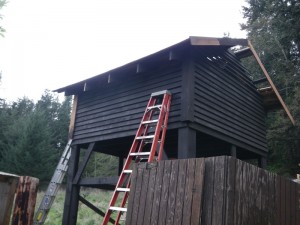Contributed by Russel Barsh
Friends of Moran State Park have completed the first bat maternity house in the San Juan Islands with technical support from the Lopez-based conservation laboratory Kwiáht. The elevated shed-like structure will provide habitat for a colony of rare Long-Eared Myotis bats that will be disturbed by repairs to the roof of the 75-year-old Park Manager’s Office.
Female bats congregate each spring to give birth and nurse their young together. Bats return to the same locations every year, like salmon, and each seasonal “maternity colonies” may support hundreds to thousands of bats that spend the rest of the year living in smaller groups. “All of the bats in the islands may depend on fewer than 25 maternity colonies,” explains Kwiáht’s director, Russel Barsh. “This makes it important to locate and protect those sites, and we’ve only just begun.”
Nearly all published designs for “bat houses” are intended for day roosts or winter hibernation of small numbers of bats, and not for spring maternity colonies, which need much more space. Kwiáht recommended a shed-on-stilts design that has been tried with some success in other States. Friends of Moran State Park adopted the project, Park Manager Jim Shue located the materials, Orcas High School science teacher Greg Books developed the construction plan and built the structure with volunteer support from Dan and Michel Vekved, Mark Morris, Linda Sheridan, and Russel Barsh.
Kwiáht has donated a state-of-the-art infrared digital video camera to install in the maternity house to monitor bats’ activity without disturbing them. An interpretive kiosk is planned for the future, with live “bat-cam”.
Barsh points to his recent re-discovery of a colony of rare Townsend’s Big-Eared Bats in a barn on San Juan Island as evidence that old barns, cabins, and rustic log structures like the Park Manager’s Office may be the homes of some of the county’s rarest and least studied mammals. Kwiáht has developed a countywide “bats and barns” program with the historic preservation association Friends of 100 Old Island Barns, to help landowners maintain old structures without dislodging bat colonies. The new Moran State Park maternity colony house is an experimental prototype for situations where old buildings cannot be saved, so bats must be offered alternative habitat nearby.
Kwiáht welcomes inquiries about bat conservation in the islands, and asks that islanders bag and freeze dead bats for identification and genetic archiving. For help with injured, confused or trapped bats, call Wolf Hollow Wildlife Rehabilitation Center, which will rescue the animal and share the data with Kwiáht.
**If you are reading theOrcasonian for free, thank your fellow islanders. If you would like to support theOrcasonian CLICK HERE to set your modestly-priced, voluntary subscription. Otherwise, no worries; we’re happy to share with you.**








Yes, the “Bat Hotel” is a very unique structure, and hopefully very vital to the survival of local bats. In addition to the people listed in the article, other volunteer helpers include Ridley Folkins, Ryan Ivans and Josh Lawson. Now we just have to wait and see if the bats like it!!
gb
I found a beautiful dead bat on my driveway 7/5/2010. I did bag and freeze the critter. Please advise who I should contact.
I would be interested in helping with conservation of any kind.
Kathy